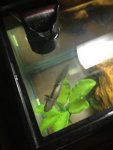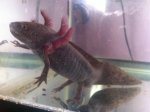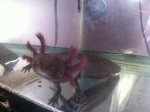Dr. Ed Zalisko - BC Floater lead researcher
Hello to all:
I am Ed Zalisko, Professor of Biology at Blackburn College. I was the professor leading my students in describing the new Blackburn College Floater phenotype, first reported at the Society for Integrative and Comparative Biology meetings in Jan. 2009.
I saw a few questions posted already and thought I might be able to help a bit.
We first noticed the phenotype in our first axolotl cross of spring 2005. About 25% or so of nearly 200 animals were variously floating at the surface. As an undergraduate and masters student, I took care of specimens of new, yet to be describes axolotl species under the supervision of Dr. Ron Brandon. A quick search of axolotl species reveals Dr. Brandon's important contributions to axolotl biology and his work describing new species. So I had one heck of a good mentor.
In my student days raising axolotls, we would sometimes see a few larvae, perhaps 1-2%, floating at the surface. Typically, we could see an air bubble or two in the animals' intestines. In short, they needed to burp or fart their way back to health.
So in 2005, when we had about a quarter of our animals floating, it was a sign that something else was up. And just about anyone who has learned basic genetics understands recessive alleles can appear at about 25% when two heterozygotes are crossed. So right away, in 2005, I started wondering about an inherited trait that caused the floating.
When I looked more closely, and in hundreds of photographs I took of floaters, it is clear that the lungs, and not intestines, are hyper inflated. The condition seems to be anatomically based, in which inspiration can occur, but that there are varying degrees of difficulty exhaling. As I note in the video some of you might have viewed, it is lucky that the sustained inflation of the lungs extends the gills downward when the animal floats upside down. Thus, the gills extend fully and may in fact become more efficient at gas exchange.
In our original Jan. 2009 description and naming of this new axolotl phenotype, we describe the series of crosses we performed, repeating the original cross and conducting additional crosses of the same male with other females.
I saw a posting wondering about how floaters can transfer sperm and thus reproduce. In 2006-2008, we learned that helping floaters stay down, for perhaps 24 hours, causes many of them to deflate their lungs. Sometimes the air escapes, perhaps due to increased pressure at greater water depths, or perhaps the air in the lungs is slowly absorbed into the bloodstream. Regardless of how the air is lost, animals that can be driven down deeper by a strong trickle filter, and which can stay down by grabbing bottom substrate, often stay down and stop floating. Currently in the Blackburn College Floater colony, we have about 50 animals that are such recovered floaters. It is such animals that we use in crosses to produce more floaters, and test the inheritance patterns.
Research that we hope to present in the next year, at an upcoming SICB meeting, will share experiments we performed regarding this loss of the inflated lungs. We keep some animals submerged for 24 hours and found about half had lost the air in their lungs (I don't have the data with me at this moment). So then we wondered, what will happen if we next leave the animals alone in still water for another day. The answer, again generally speaking, is that about half of those who had deflated lungs due to submersion, reacquired the hyper inflated lungs and began floating again. So it looks like keeping floaters in a tank with a trickle filter, generating a downward flow, can stop many floaters from floating (data on this was presented in our 2009 poster).
As to any adaptive advantage of the floater trait. I see the trait as another, in a long line of mutations that does not reflect a natural adaptation. Instead, it is likely a mutation that was acquired in the many decades of axolotl inbreeding that is characteristic of lab. axolotls. There are so many known lethal traits.
But I am always interested in questions, and comments, regarding our student project.
And before I end, let me give a pitch for Blackburn College. We have about 500 students total at the college, and about 20-25% are biology majors of various sorts. It is a very big biology program. We are now housed in a new, very large science building and my new axolotl research lab. will be completed this spring. All resident students, and many commuters, participate in our work program, in which students work for 10 hours a week to help run the college. In addition to building the majority of our campus buildings, the students maintain the facilities, and in the sciences, help teach the labs. (professors are always teaching the labs too). And my workers help keep the axolotl colony going. In fact, the first author of the 2009 paper worked all 4 years with me as part of the work program, just doing research on the BC Floaters. In addition to working closely with faculty, and developing a spectacular campus community, the cost to go to our college is the same or cheaper than state universities!
OK. That's it for tonight.
I do not know that I will be able to check this blog often, or much at all.
However, I invite emails to my college address.
My email address is:
ezali@blackburn.edu
I shall try to respond to as many as I can. But please understand. I have to attend to the needs of my students first. My students are, after all, the reason I teach.
My best to all,
Ed Zalisko, Ph.D.
Professor of Biology
Blackburn College





